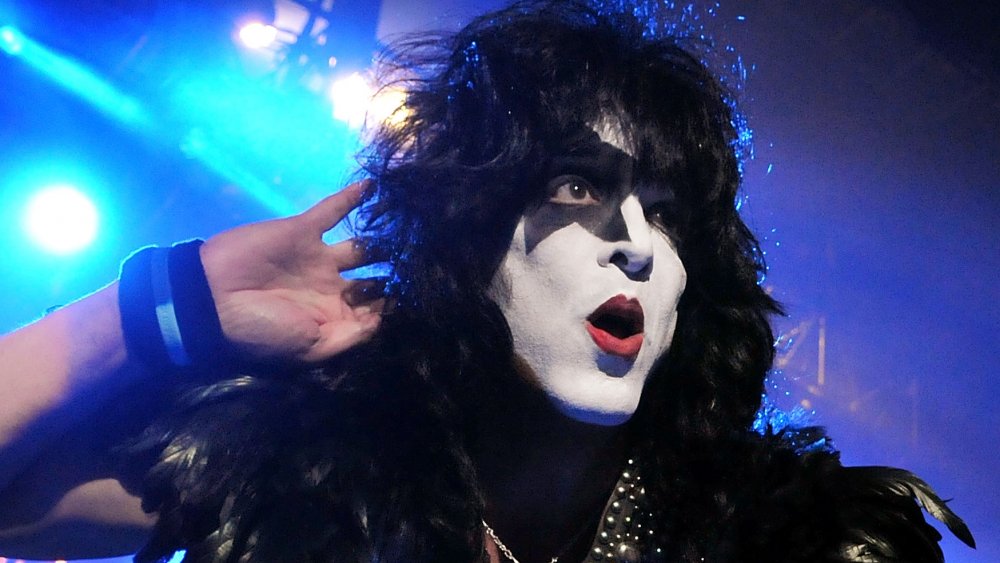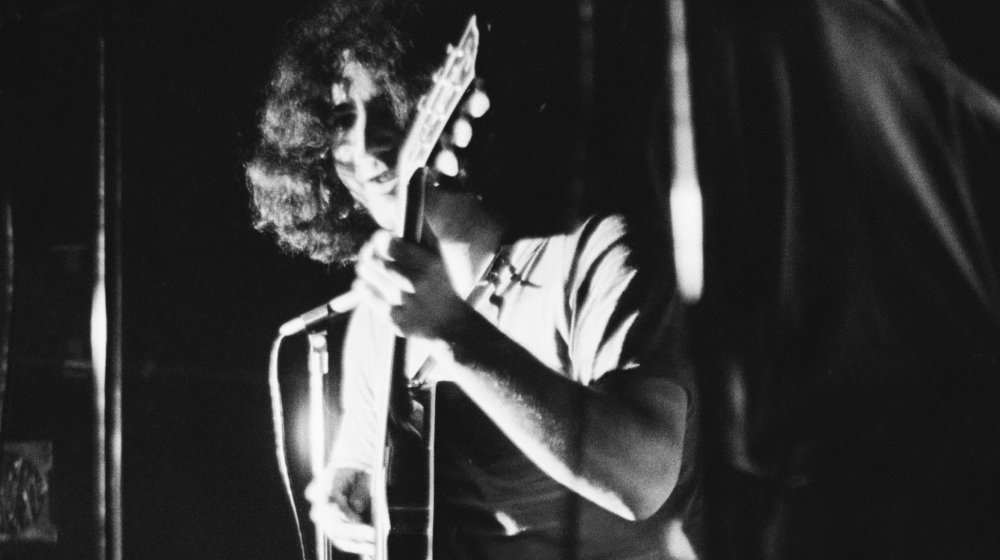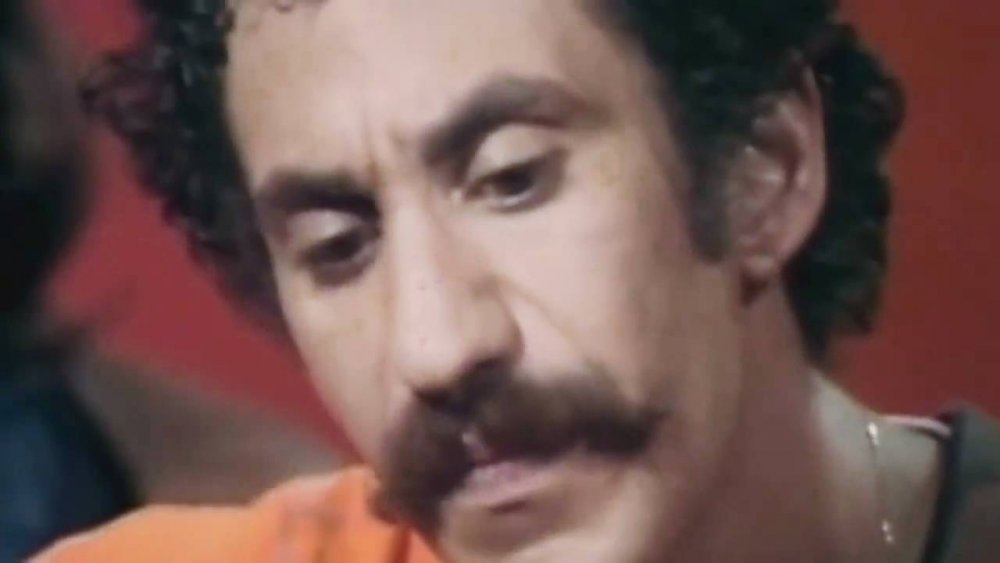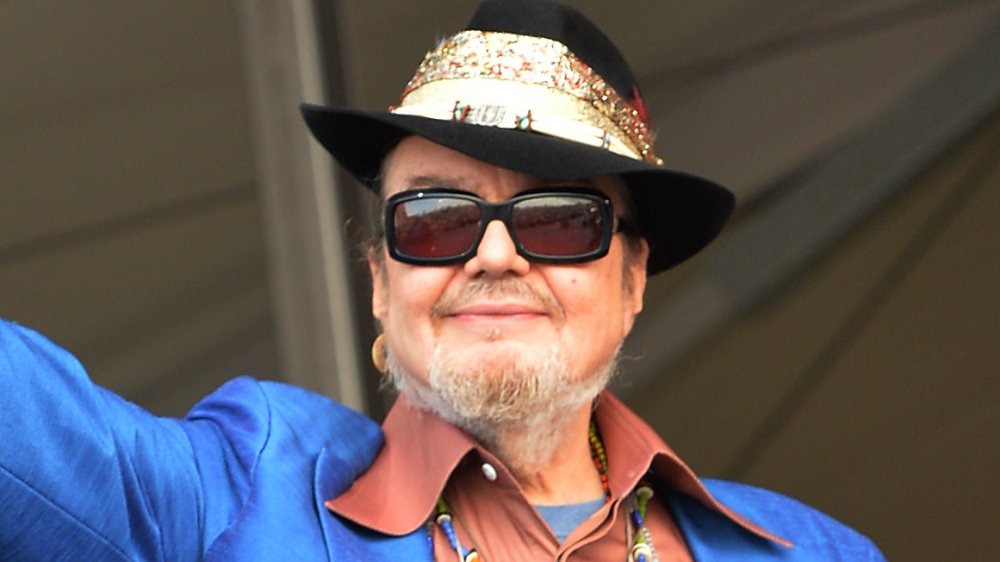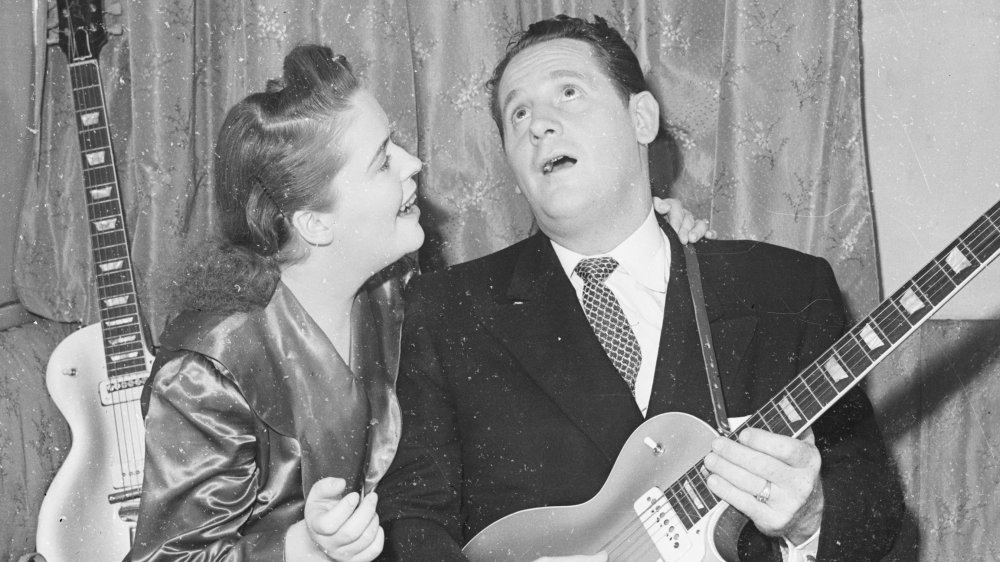Rock Stars You May Not Know Are Missing Body Parts
Being a rock star has to be one of the greatest jobs — and feelings — in all of existence. Not only do these lucky individuals get to spend their lives following their creative muse, but they get well-compensated for their troubles, in the form of financial riches and the unending adulation of appreciative fans.
Ranking much farther down that hypothetical list of "things that would be nice for a human being to experience" is losing a portion of one's body to injury, illness, accident, or congenital anomaly. Fingers, legs, arms, bones — these limbs and appendages really become a part of a person, even after only a short time. Lacking a vital element of the body, one that most everyone else on the planet takes for granted, can understandably cause major obstacles for a person. And that's especially true if your whole job is being a rock star and making music with, you know, your body. However, the musicians on this list overcame those challenges and went on to live grand lives. From old-timey performers to heavy metal stars, these famous rock stars had incredible careers even though they were missing various body parts.
Jerry Garcia's missing appendage
Almost anybody can pick up a guitar and learn to play it. However, a handful of guitarists go on to form bands and make enduring art that brings them fame and fortune. But only a precious few of those musicians go on to inspire a thriving subculture, a la Jerry Garcia, the merry leader of the Grateful Dead, the original jam band and source of near-worship by its army of Deadheads. Garcia and company trucked along on a seemingly endless tour for 30 years (from 1965 until Garcia's death from a host of medical problems, including a heart attack). And to think he became one of the world's most acclaimed and well-known guitarists with only nine fingers (especially impressive considering how important fingers are for a musician).
When they were both kids, Garcia's older brother, Tiff, cut off Jerry's finger with an ax. Of course, it was (kinda) accidental. "He was putting little pieces of twigs on the sawhorse, or whatever, and I was chopping them in half, making kindling," Tiff related on the Garcia tribute DVD Move Me Brightly, before adding, "He'd put his finger there and take it away. That happened a dozen times. Finally, I just nailed him. So they had to remove it."
The truth about Tony Iommi's fingers
In the early 1970s, Ozzy Osbourne and Black Sabbath pioneered heavy metal, combining a loud, dark, and grungy sound with wailing lyrics about war, death, mental illness, and other things contemporaries like Three Dog Night didn't dare to cover. It's fitting then that one of the chief architects of metal, Black Sabbath guitarist Tony Iommi, paid the bills before his music career took off by working in a sheet metal factory in the English industrial city of Birmingham.
Iommi worked as a welder, but one day, he was moved to a different part of the factory and put to work on a "giant, huge press — a guillotine-type press." As Iommi explained to Loudwire, "I don't know what happened, I must have pushed my hand in. Bang! It came down. It just took the ends off." The ends off what? Well ... his fingers. "It was left with two stalks, the bone was sticking out the top of the finger." Doctors cut off the bones and told Iommi that without a full hand of fingers, his guitar-playing days were over, a fate he couldn't accept. So instead, he created prosthetic tips out of everything from melted plastic to cloth, finally deciding that cut-up bits of a leather jacket gave him the leverage to grip down on guitar strings.
This Def Leppard rock star lost his arm
In 1997, the humorous rap-rock group the Bloodhound Gang released the single "Why's Everybody Always Pickin' on Me?" It included a shouted refrain that went, "The drummer from Def Leppard's only got one arm!" So what's that about? Well, they're pickin' on Rick Allen, who really was left with one upper appendage after a New Year's Eve 1984 car accident.
While driving on the A57 motorway outside Def Leppard's hometown of Sheffield, England, Allen's Corvette Stingray slipped out of his control. It struck a brick wall at a high speed, and the impact came at such tremendous force that it unbuckled Allen's seatbelt. As the car expelled Allen via the sunroof, his arm got caught on the seatbelt ... and detached from the rest of his body. Amazingly, Allen spent only a month in the hospital and resumed his duties behind the kit for Def Leppard in August 1986. He obviously couldn't play the drums the way he used to, so ever since, he's been assisted by a pedal-powered, electronic drumming system.
Paul Stanley was missing an ear for a long time
Buried under black-and-white face makeup that presented him to the world as "the Starchild," KISS singer and guitarist Paul Stanley played some of the loudest music in the world to arenas packed full of adoring fans in the '70s and beyond. KISS concerts probably shattered more than a few eardrums, but long before he rocked and rolled all night and partied every day, Stanley began life with major hearing problems.
"I was born with a Level 3 Microtia, which is a congenital deformity of the cartilage of the outer ear," Stanley told CNN. He went on to explain that, "There is no ear canal and no direct path to the inner workings of the ear." The condition left the young Stanley "virtually deaf" on his right side, and it also gave him an underdeveloped mound of flesh where his outer ear would've been. As an adult, Stanley corrected both issues. Along with receiving implanted hearing aids, a surgeon removed cartilage from the singer's rib cage and made an artificial ear out of it, which was then grafted to Stanley's head.
What's up with Thom Yorke's eye?
For almost 30 years now, Thom Yorke has led his band Radiohead to worldwide success, almost inexplicably so, what with the group's progressive, challenging, envelope-pushing rock. Singing seven-minute, multi-part epics like "Paranoid Android" or asking fans to pay whatever they felt like for the 2007 album In Rainbows are two examples of what makes Yorke a rock star like no other.
Another thing that makes him uniquely himself? His appearance, including a left eye that appears drooping or semi-closed. That all goes back to a medical condition discovered when the singer was born in 1968. "My eyelid was permanently shut, and they thought it would be like that for the rest of my life," Yorke told Rolling Stone (via FRIDgE BUZZ). "Then some specialist bloke realized he could graft a muscle in, like a bionic eye." He endured five operations by the age of six, but doctors botched the last one, leaving his eye in a permanently droopy state.
This Korn rock star had a terrible childhood accident
Of all the rap-rock bands that stormed the album charts and the TRL studios in the late '90s and early 2000s, Korn sat at the top of the tattooed heap. Hardcore Korn-heads couldn't get enough of the gravelly vocals of Jonathan Davis, the low-end grooves of bassist Reginald "Fieldy" Arvizu, and the intricate guitar work of James "Munky" Shaffer. According to Leah Furman's Korn: Life in the Pit, a teenage Shaffer actually started playing the guitar in the first place as a form of physical therapy. But why did he need therapy, you ask?
Well, one night, 14-year-old Munky tried to sneak out of his house to attend a keg party. As he attempted to ride away, the bike chain came loose and started making a loud, repetitive noise. Seeking to silence the bike so as to not get caught by his parents, he grabbed hard at the chain. And that's when the chain and teeth of the sprocket on the moving bicycle trapped young Munky's left index finger, mangling it horribly. While he initially had no feeling in the partially-severed finger, doctors were able to save it and thought sensation would return faster if the teen played an instrument as therapy.
Jim Croce's style comes from a messed up finger
Jim Croce absolutely ruled the music charts in the early 1970s. A folky pop singer in the vein of James Taylor or Neil Young, his rollicking story songs captivated audiences. His 1972 and 1973 albums You Don't Mess Around with Jim and Life and Times were smash hits and generated successful tunes like "You Don't Mess Around with Jim" and "Bad, Bad Leroy Brown." That upward trajectory came to a tragic halt in September 1973, when the 30-year-old singer-songwriter died in a plane crash.
While Croce's success was substantial and fleeting, it also came despite a potentially silencing injury. According to a 1973 feature in Guitar Player, Croce played gigs at night and worked various jobs during the day. During one of those, he accidentally smashed his right index finger in a mishap involving a sledgehammer. Unable to use that very important finger in his guitar-playing any longer, he developed a distinctive picking style that involved his other three fingers, as well as his thumb.
The sad truth about Leslie West's surgery
In the summer of 1969, the hard rock band Mountain secured both its legacy and its Baby Boomer generational cred forever when it played a set at the Woodstock Festival. The group's biggest hit, the riff-and-cowbell heavy "Mississippi Queen," reached #21 on the Billboard Hot 100 and endured as a classic rock radio staple and beer commercial background music. Founder, guitarist, and singer Leslie West kept playing music in various bands and as a solo act, even after a personally devastating partial leg amputation in 2011.
"I cried a couple f****n' times. I look down — 'Where is it?!'" West told Billboard of the aftermath of the surgery, in which doctors removed the lower half of his right leg due to the ravages of diabetes. West now gets around with the aid of wheelchairs, which he considers good luck. "But I'll tell you. It's a good thing it wasn't one of my arms. Then I'd really be f****d," he said, because he doesn't need a leg to play the guitar and make music.
Dr. John could've lost his life but lost a finger instead
The late Dr. John (real name Malcolm John Rebennack) took the unique sound of New Orleans, put a pop-rock spin on it, and brought it to the mainstream in the '60s and '70s. With a little bit of blues, a little bit of jazz, and a little bit of funk, the raspy-voiced Big Easy icon is most remembered for his 1973 top ten hit "Right Place Wrong Time," notable for Dr. John's blazing keyboard work.
He came relatively late to key-based instruments, after he'd established a career as a live and session musician, but he kind of had no choice. In a 1960 show in Jackson, Mississippi, Dr. John was playing his first main instrument, the guitar, with a band. A fight broke out, somebody pulled out a gun, the gun went off, and the bullet struck Dr. John in the ring finger of his left hand. It's amazing the force didn't blow the thing clean off, but Dr. John couldn't move it for so long that his guitar work suffered. And so, he switched to piano and keyboards and did pretty well for himself in the long run.
Les Paul was involved in a major accident
"Les Paul" isn't just the name of an extremely famous solid body electric guitar favored by countless rock stars past and present. It's also the name of a man — the man who helped design that sweet ax for Gibson back in the early 1950s. Up to that point, Les Paul had been a successful jazz and pop guitarist and recording wizard. He even hit #1 in 1945 with "It's Been a Long, Long Time," a collaboration with Bing Crosby.
His career was on the rise until it was cruelly interrupted by a 1948 automobile accident. His elbow was completely shattered, and surgeons couldn't properly rebuild it. Facing a future without playing guitar — his means of financial support and artistic fulfillment — Paul talked the doctors into fusing what was left of his elbow at a 90 degree angle, the guitar-holding position. After he recovered, Paul married singer Mary Ford, and the duo racked up a slew of hits and starred in an NBC radio show together.
This rock star suffered a pretty metal injury
Meshuggah is among the loudest, heaviest, and most metal bands that ever metaled. The Swedish outfit has been a going concern for more than 30 years now, combining unique rhythms and jazz elements with some good, old-fashioned thrash to create a distinctive, rumbling sound all its own. A lot of that auditory assault comes courtesy of founding member Fredrik Thordendal, named by Guitar World as one of the best heavy metal guitarists of all time. But in the early '90s, well after the band had released several collections and established an international following, Thordendal suffered a setback. While working on a carpentry project, he sliced off the tip of the middle finger on his left hand. Doctors sewed it back on, leaving the damaged finger and index finger the same length. More importantly, he was able to play again, and this story is way more metal than anything Meshuggah ever recorded.
Andrew Tkaczyk has overcome a missing leg
In November 2015, a bus carrying the popular indie metal band the Ghost Inside, along with its crew, collided with an 18-wheeler truck. The drivers of both vehicles perished in the accident, while the whole of the band's operations survived, although some just barely. Early reports listed vocalist Jonathan Vigil and guitarist Zach Johnson in critical condition. Drummer Andrew Tkaczyk was airlifted out of the scene of the crash for treatment of head trauma and multiple bone breaks. From the hospital where he would spend two months after the crash, Tkaczyk posted to Instagram an update on his recovery in January 2016. He revealed that after the accident left him in a coma for ten days, he awoke "to the sight of my missing leg." Surgeons had to amputate the severely damaged appendage, which Tkaczyk notes was "one injury among many others such as fractures in my ribs, spine, and hip along with some ligament tears in my rotator cuff and labrum." He promised to "play drums again," and he did. The Ghost Inside returned to the stage in 2019 for its first show since the bus accident.
How Fetty Wap lost his eye
If rock stars put forth a unique, imitable style and create music that speaks to the issues of a youthful generation while simultaneously upsetting and offending that audience's parents, then rappers are definitely the new rock stars. Hip-hop artist Fetty Wap (real name: Willie Maxwell II) broke out in a big way in 2015 with his chart-topping, double-platinum self-titled debut album, along with three smash hit singles: "Trap Queen," "679," and "My Way." Fetty Wap rocks a unique appearance, which includes multiple tattoos on his face and neck, along with a left eye that doesn't look like most other people's left eyes. The reason: That eye socket is virtually empty.
"I was born with glaucoma and I lost the eye at six months," the rapper told TMZ. While doctors were able to preserve both the right eye and his ability to see, nothing could save the left eye. "I got reconstructive surgery when I was 12, and I just stopped wearing the prosthesis because I didn't want to look like everybody else."
